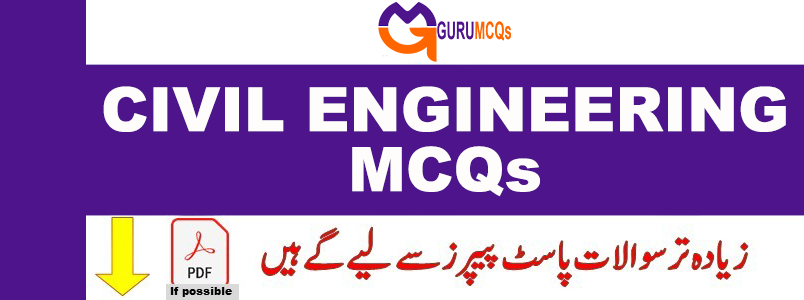
GURU MCQs provides Civil Engineering MCQs for Job Test and Interview Preparation, suitable for fresh graduates, students, and competitive exams. Most repeated civil engineering MCQs section is frequently encountered in CSS, PMS, Inspector, ASI, Sub-Inspector, Constable, FPSC, PPSC, ETEA, FIA, Police, Army, Navy, Airforce, IB, MOFA, ASF, LHC, Educators, and various other competitive exams, as well as government and private job assessments. The most common updated MCQs include Basic Civil Engineering, Building Materials, Surveying, Soil Mechanics and Foundation Engineering, Applied Mechanics, Hydraulics, Waste Water Engineering, RCC Structures Design, Irrigation, Railways, Construction Management, Theory of Structures, Estimating and Costing, Docks and Harbours, Elements of Remote Sensing, Building Construction, Concrete Technology, Advanced Surveying, Strength of Materials, Water Resources Engineering, Water Supply Engineering, Steel Structure Design, Highway Engineering, Airport Engineering, Structural Design Specifications, Tunnelling, and much more.
**171. Which of the following is a type of prestressed concrete?**
A. Reinforced concrete
B. Post-tensioned concrete
C. Pre-tensioned concrete
D. All of the above
**172. The purpose of providing steel reinforcement in concrete is to:**
A. Increase the tensile strength
B. Increase the compressive strength
C. Improve workability
D. Reduce the cost of construction
**173. Which of the following admixtures is used to accelerate the setting time of concrete?**
A. Retarder
B. Accelerator
C. Plasticizer
D. Air-entraining agent
**174. The term ‘formwork’ in construction refers to:**
A. Temporary structures used to support freshly placed concrete
B. Permanent structures used to provide shape and finish to concrete
C. Reinforcement bars used to strengthen concrete
D. Admixtures added to concrete to enhance its properties
**175. The process of removing excess water from freshly placed concrete by applying pressure is known as:**
A. Curing
B. Sealing
C. Compaction
D. Drying
**176. Which of the following is NOT a method of concrete curing?**
A. Ponding
B. Steam curing
C. Air drying
D. Membrane curing
**177. The phenomenon of the increase in volume of concrete due to the hydration of cement is known as:**
A. Shrinkage
B. Swelling
C. Creep
D. Expansion
**178. Which of the following factors does NOT affect the strength of concrete?**
A. Water-cement ratio
B. Aggregate size and shape
C. Temperature during curing
D. pH level of concrete
**179. The process of compacting concrete using internal vibration is known as:**
A. External vibration
B. Internal curing
C. Internal vibration
D. Surface vibration
**180. Which of the following aggregates is lightweight and used in making lightweight concrete?**
A. Gravel
B. Sand
C. Expanded shale
D. Crushed stone

Pingback: Software Engineering MCQs for Preparation - GURU MCQS